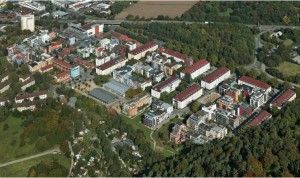SURF is a supportive member of Scotland’s Towns Partnership, a collective body tasked with supporting key aspects of the Scottish Government’s Town Centre Action Plan. One of the Partnership’s main activities is a high-profile annual event that aims to raise the profile for town centre regeneration and bring practitioners together to consider practical ideas.
The 2015 Scotland’s Towns Conference took place in Falkirk Town Hall on 18 November, and SURF’s Derek Rankine was among the 100+ participants in attendance. For the interest of the SURF network, his summary of three of the keynote presentations follows below:
Ministerial Address
The Scottish Government’s Minister for Local Government and Community Empowerment, Marco Biagi, opened the conference with a broad overview of the contextual challenge for Scotland’s towns and the Scottish Government’s response.

The conference was held in Falkirk
The reality, he noted, is that the trend for consumers to buy more goods online and from out-of-town shopping centres will continue. We therefore can’t depend on the resurgence of a strong town centre retail trade to drive the economic regeneration of towns. This understanding, he said, was at the heart of the Town Centre Action Plan, which focused on enhancing town centres as attractive places to live, work and socialise in. The Town Centre First Principle, which was created through the Action Plan, asks local authorities to “think beyond the bottom line” when balancing the short-term and long-term benefits of policies and investments that affect town centres.
Mr Biagi said that several Councils, including Aberdeenshire, East Ayrshire and North Ayrshire, had proved particularly adept at putting the principle into practice. Noting the 27k privately owned long-term vacant housing in town centres, he said that creating “living town centres” was another central Action Plan objective. He identified Angus Council’s 2014 SURF Award winning social housing redevelopment project Glengate Hall in Kirriemuir as a model of best practice in this regard. He also said that the SNP administration has expressed a commitment to create 50k new affordable homes in the next Scottish Parliament, if re-elected in 2016.
Among other initiatives, Mr Biagi highlighted the Scottish Government’s enthusiasm for community charrettes, case study planning pilots, stalled spaces, the Business Improvement Districts model, and cluster approaches to town centre regeneration. He accepted that this represented an experimental approach in support of a wide diversity of demonstration projects, some of which would ultimately prove ineffective while others would deliver real impacts. He argued that this “letting 1000 flowers bloom” method suited the reality that there are as many different paths to successful regeneration as there are towns in Scotland, as each town has a unique history, identity, and set of challenges, opportunities and stakeholders.
The Future for Scotland’s Towns
Prof. Richard Kerley, Chair of the Centre for Scottish Public Policy and Professor of Management at Edinburgh’s Queen Margaret University, challenged the audience to think about what Scotland’s town centres will look like in a couple of decades. In a thought-provoking input, he provided an outline of his perception of the main trends, prospects and concerns, and some of the main questions this raised for him:
- Should we treat large towns like Paisley, Dunfermline and Falkirk differently from those with city status such as Inverness, Perth and Stirling – and if so, why? For example, Paisley, a town, has a population more than twice that of Inverness, a city.
- How do we address the reality that many people using Scottish town centres have a dysfunctional relationship with alcohol? In contrast to towns in much of continental Europe, alcohol-fuelled violence and anti-social drunk behaviour can be a common sight in Scottish town centres at evening and weekends, making them much less attractive places to spend time in.
- Many town centres are promoted as being great places to visit in sunny weather, with marketing literature focusing on dry, bright weather and outdoor festivals. But what happens during wet/overcast days, which is a more common experience for most Scottish places?
- Are some policy tools overplayed in debates? For example, a local authority being able to offer £30 a week discount on rateable values may find that this makes little difference to attracting a successful business into a vacant town centre space.
- Are housing ‘adjacencies’ entrenching disconnections? New developments in towns such as Airdrie and Alloa tend to be adjacent to, but not part of, the town centre fabric. People living in these new houses tend to travel to work in Glasgow or Stirling, and shop in retail parks there, but don’t spend a lot of time in the local town centre.
- Do we understand the value created or lost by enhanced transport connections? The new Borders-Edinburgh railway received welcome positive coverage, but it may take five years before the flow of advantages between central Edinburgh and towns in the Borders become clear.
- Can we take specific surgery to de-size high streets that are simply too large for demand? Town centres have been subjected to “random downsizing” with a legacy of scattered long-term empty buildings. Other buildings have clear “marginal demand” and may be occupied for short periods from time to time but cannot be sustainably let over the longer term.
- Do architectural forms that can create a welcoming environment in all weather, such as the Princes Square enclosed shopping/restaurant area in Glasgow, have more of a role to play in encouraging businesses to invest in town and city centres?
- Can synchronisation among town centre business owners present a simple and low-cost opportunity to add value? In some French towns, for example, local restaurants collaborate to agree on late night openings and holiday periods, so that at least one restaurant is open throughout the week for visitors and residents.
An International Vision
Cord Soehike has been Mayor of Urban Building, Planning and Development in the large German town of Tubingen since 2010. A University town with a population of 85k, Tubingen is located in south-east Germany, around 20 miles south of Stuttgart. Cord has a wide-ranging background in architecture, journalism, academia, public relations and economic development, and has spent most of his career in the town.

Tubingen’s new cooperatives were created on a former French military base
Throughout the West Germany era, Tubingen was notable for having a sizeable active French military base in the south of the town. The extensive barracks and facilities were abandoned by the French in the early 1990s, being seen as surplus to requirements after reunification with East Germany and the end of the cold war. By this time, a number of factory and transport infrastructure sites in the town had also become vacant, a legacy of post-industrial degeneration.
In the late 1990s, the local authority began buying some of the vacant military and industrial brownfield land with a view to stimulating regeneration and development by developing a vibrant new urban quarter. The model used is termed ‘private building cooperatives’. Cord provided an outline of the innovative approach, which:
- Involves the construction of small-scale, mixed-use, low-rise developments, with shops, offices and manufacturing workspaces on the ground floor of low-rise residential housing.
- Are community enterprises, led by a partnership of individuals, families and small businesses who purchase units prior to construction. This partnership is supported by a lead architect and a local authority project manager.
- Have high urban density and a broad social mix, with affordable housing units and luxury penthouse apartments sharing the same building.
- Re-use old buildings as far as possible, and landscape public spaces between developments as attractive ‘outdoor living rooms’.
- Are around 15-20% cheaper than a comparable private sector development.
- Treat local people as ‘actors’ rather than ‘victims’ of urban development.
- Are built to a high standard and aligned with the local authority’s wider sustainable development strategy for the town.
Visit the Scotland’s Towns Partnership website for more information on their activities and access to Town Centre Toolkit, Understanding Scottish Places and Funding Finder resources.
SURF, Scotland’s Towns Partnership and others have teamed up to deliver a Scotland’s Most Improved Town category as part of the 2015 SURF Awards for Best Practice on Community Regeneration. Borders, Irvine, Kelso and Kilmarnock are shortlisted and the outcomes will be revealed at next month’s SURF Awards Presentation Dinner event in Glasgow.
